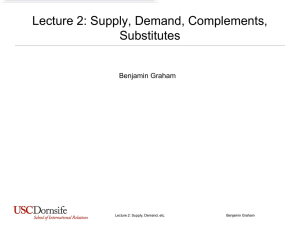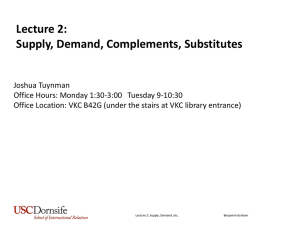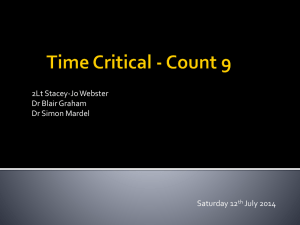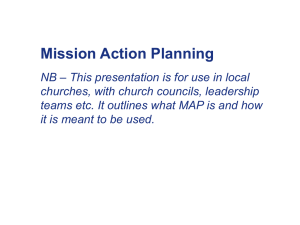Lecture 2: Supply, Demand, Complements, Substitutes
advertisement
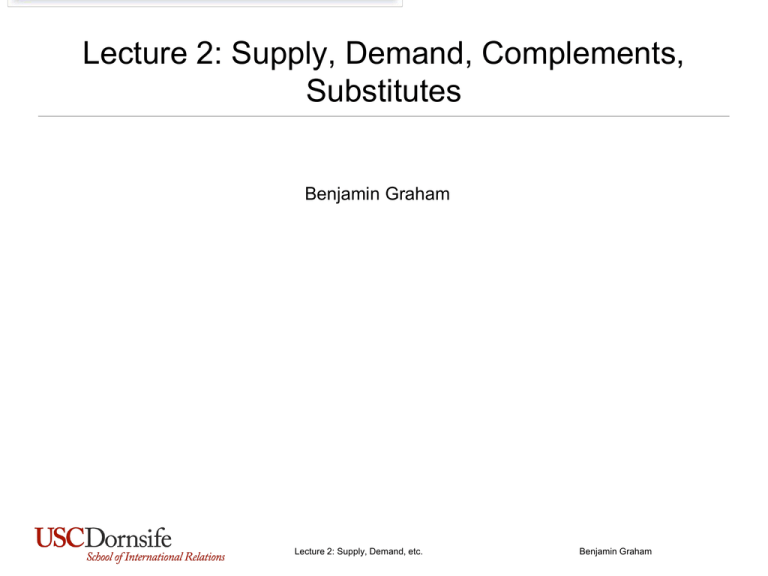
Lecture 2: Supply, Demand, Complements, Substitutes Benjamin Graham Lecture 2: Supply, Demand, etc. Benjamin Graham Today’s Plan • Housekeeping • Supply and Demand • Demand vs. Quantity Demanded • Supply vs. Quantity Supplied • Complements and Substitutes Lecture 2: Supply, Demand, etc. Benjamin Graham Housekeeping • No section this week • Make sure your clicker is working today • Guest lecture next Monday • Class CANCELLED next wednesday Lecture 2: Supply, Demand, etc. Benjamin Graham Mock Reading Quiz • Peanut butter and jelly are: • A. Complementary Goods • B. Substitutes • C. Superior Goods • D. Partner Goods • E. Welfare-maximizing Goods Lecture 2: Supply, Demand, etc. Benjamin Graham Why we’re starting with supply and demand • As bedrock as bedrock gets • We usually talk about goods • S&D also explains prices for labor (i.e. wages) • It even explains the value of currencies Lecture 2: Supply, Demand, etc. Benjamin Graham Demand (individual) Lecture 2: Supply, Demand, etc. Benjamin Graham Demand (market) Lecture 2: Supply, Demand, etc. Benjamin Graham Demand vs. Quantity Demanded Lecture 2: Supply, Demand, etc. Benjamin Graham Demand vs. Quantity Demanded Changes in the price of oil cause the demand curve for oil to shift, whereas changes in the fuel efficiency of cars cause a movement along the demand curve for oil. A. True B. False Lecture 2: Supply, Demand, etc. Benjamin Graham Quick Question What affects the demand for automobiles? Lecture 2: Supply, Demand, etc. Benjamin Graham Supply (individual) Lecture 2: Supply, Demand, etc. Benjamin Graham Supply (market) Lecture 2: Supply, Demand, etc. Benjamin Graham Quick Question What affects the supply of automobiles? Lecture 2: Supply, Demand, etc. Benjamin Graham Clicker Question If the price of automobiles went up, what would happen? A. The supply curve would shift right B. The supply curve would shift left C. The quantity supplied would increase D. The quantity supplied would decrease E. A&C F. B & D Lecture 2: Supply, Demand, etc. Benjamin Graham Supply Meets Demand Lecture 2: Supply, Demand, etc. Benjamin Graham Markets Not in Equilibrium Lecture 2: Supply, Demand, etc. Benjamin Graham What Creates Surpluses and Shortages? • In the 1970s, there was a gasoline shortage in the US. •What caused the shortage? •What would have happened if the price controls were removed? Write down what would have happened to supply, demand, quantity supplied, and quantity demanded. Lecture 2: Supply, Demand, etc. Benjamin Graham Demand Shock Supply and Demand Both Move Normal Goods vs. Inferior Goods • Normal good: higher income, higher quantity demanded • Inferior Good: higher income, lower quantity demanded • Let’s brainstorm a few of each Lecture 2: Supply, Demand, etc. Benjamin Graham Complements and Substitutes • Two goods are complements the consumption of one item increases the demand for the other • bullets and handguns • Computers and IT specialists • Two goods are substitutes if the consumption of one item decreases the demand for the other. • Buses and Trains • Robots and assembly-line workers Lecture 2: Supply, Demand, etc. Benjamin Graham Clicker Question • Right now the price of a gram of cocaine in the US is lower than it was in the 1970s (adjusted for inflation). Which of the following could explain that? • A. Supply in the US is higher now than in the 70s (i.e. our interdiction efforts have worked poorly) • B. Demand in the US is lower now than in the 70s (i.e. DARE and other education and treatment programs have worked well) • C. Substitutes, like meth, have increased in supply. • D. A & B • E. A & C • F. A, B & C Lecture 2: Supply, Demand, etc. Benjamin Graham Group Questions • An aid organization buys grain in the US and ships it to a village in a developing country that is experiencing a drought. • What happens to the price of grain in the area? • What happens to the price of corn in that area? • What happens to the price of grain back in the US? • Which of the following actors gain, and who loses? • Consumers of food in the drought-stricken region • Producers of food (i.e. farmers) in the drought-stricken region • Consumers of food in the US • Producers of food in the US Lecture 2: Supply, Demand, etc. Benjamin Graham


